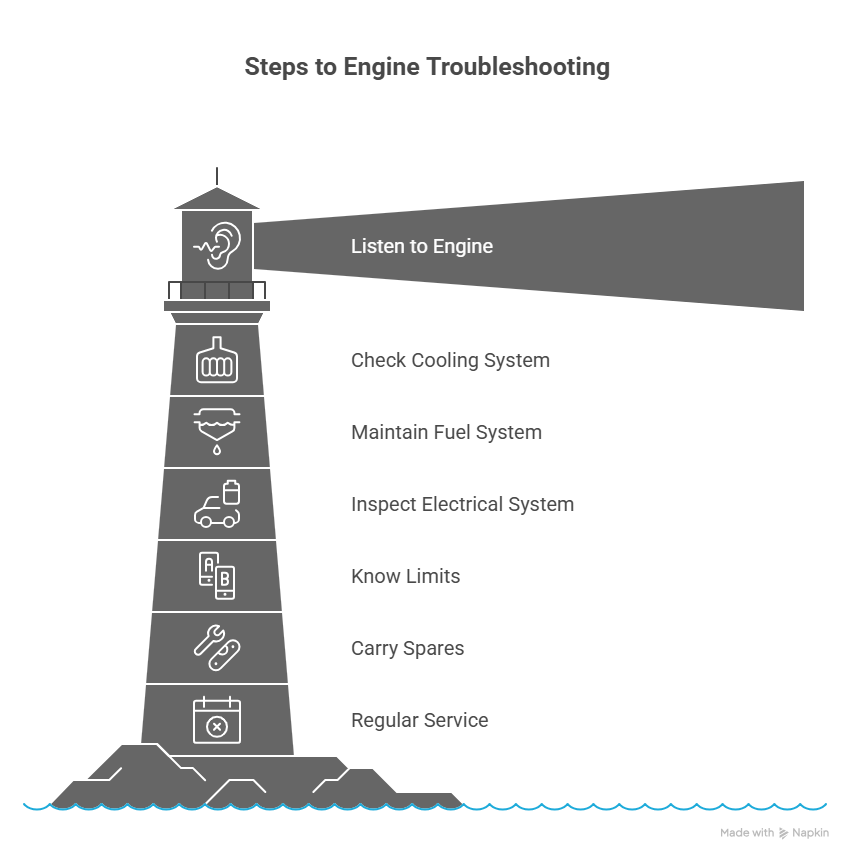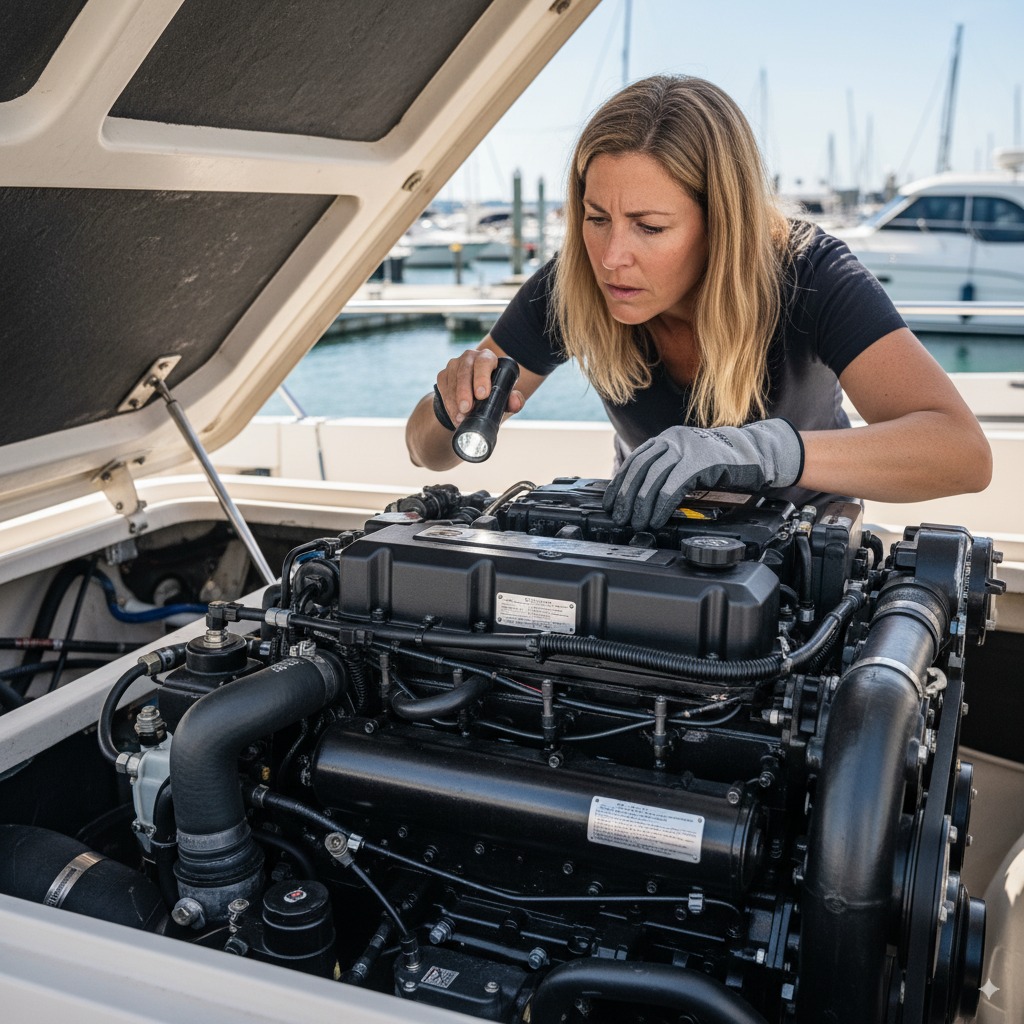I’ve been a marine mechanic in South Florida for over 15 years, and I can tell you that an engine rarely dies without giving you a warning first. The problem is, most boat owners don’t know how to read the signs.
I remember a guy named Dave who called me in a panic. He was stranded near Stiltsville with his family, his engine completely dead. He was convinced it was a catastrophic failure. When I got out there, I found the problem in about five minutes: a loose battery cable. A tiny bit of corrosion and a nut that had vibrated loose had killed his whole day. He was embarrassed, but I told him, “Don’t be. This is a classic case of troubleshooting common engine failures. You just need to know where to look.”
That’s what this guide is all about. It’s not about turning you into a certified mechanic overnight. It’s about giving you the confidence to diagnose the simple stuff, understand what your engine is telling you, and make smart decisions. A little knowledge goes a long way in troubleshooting common engine failures and can save you a tow, a ton of money, and a whole lot of stress.
Table of Contents
The First Signs of Trouble: Learning to Listen
Your engine is always talking to you. A new vibration, a strange smell, a flicker on a gauge—these are its words. Learning the language of your engine is the first step in effective troubleshooting common engine failures. Don’t wait for a complete shutdown to start paying attention.
Here are the seven critical warning signs that demand your immediate attention:
- Unusual Noises: Knocking, grinding, or squealing are never good.
- Excessive Smoke: Black, white, or blue smoke all mean different, but equally important, problems.
- Overheating: That temperature gauge is your best friend. If it starts climbing, act fast.
- Loss of Power: If your engine feels sluggish or won’t get up to its usual RPMs, something is wrong.
- Fluid Leaks: Oil, fuel, or coolant in your bilge is a major red flag.
- Hard Starting: If your engine is suddenly difficult to start, it’s telling you something.
- Excessive Vibration: A new shake or shudder means something is out of balance.
Overheating: The #1 Engine Killer
If there’s one issue that causes more catastrophic damage than any other, it’s overheating. When that temp gauge starts to climb, you have to act immediately. Shut the engine down and figure out the cause.
Here’s my step-by-step process for troubleshooting common engine failures related to cooling:
- Check the Raw Water Intake: The first thing to do is check the through-hull fitting under your boat. It’s amazing how often a plastic bag or some seaweed is the culprit.
- Clean the Sea Strainer: This is your engine’s first line of defense. A strainer clogged with grass and debris will starve your engine of cooling water. Make cleaning it a part of your regular checks.
- Inspect the Impeller: This little rubber star is the heart of your cooling system. It’s a wear item, meaning it’s designed to be replaced regularly (usually every year or two). If it fails, your engine gets no water.
Fuel System Frustrations
I’d say 80% of the problems I see are fuel-related. The mantra for troubleshooting common engine failures in the fuel system is “cleanliness and quality.”
- Clogged Fuel Filters: This is the big one. Fuel filters are cheap. Carry spares and change them often. A clogged filter will make your engine starve for fuel, causing it to lose power and eventually stall.
- Bad Fuel: Old or water-contaminated fuel is a death sentence for an engine. If you suspect you have bad fuel, you need to get it out of your tank. Use a fuel stabilizer, especially if your boat sits for long periods.
- Failing Fuel Pump: If you’ve checked your filters and fuel quality, and you’re still having issues, you might have a weak or failing fuel pump. A pressure gauge can help you diagnose this.

Electrical Headaches: The Silent Killers
Electrical problems can be maddening because they often come and go. But a systematic approach to troubleshooting common engine failures in the electrical system can save your sanity.
- Start at the Battery: Your battery is the heart of the system. Are the terminals clean and tight? I mean, really tight. A loose connection here can cause all sorts of gremlins. Check the battery voltage with a multimeter. A healthy battery should read above 12.6 volts.
- The Starter System: If you turn the key and get nothing but a “click,” you could have a problem with the starter solenoid. Check the wiring to the starter for any corrosion or loose connections.
- The Alternator: If your engine starts but the battery keeps dying, your alternator probably isn’t doing its job. A multimeter can tell you if the alternator is putting out the correct voltage (usually 13.8-14.4 volts when the engine is running).
DIY vs. The Pro: When to Make the Call
I’m all for owners getting their hands dirty. But it’s crucial to know your limits. Here’s a quick guide to help you decide when to tackle a job yourself and when to call a pro for help with troubleshooting common engine failures.
| Task | DIY or Pro? | My Advice |
|---|---|---|
| Changing Fuel Filters | DIY | Every boat owner should know how to do this. |
| Impeller Replacement | DIY | Very doable with a service manual and basic tools. |
| Battery/Terminal Cleaning | DIY | Easy and essential. |
| Alternator/Starter Swap | DIY (Intermediate) | If you’re comfortable with wiring, it’s a manageable job. |
| Diagnosing “No Spark” | Pro | This can get complicated fast with modern engines. |
| Internal Engine Noises | Pro | A knocking sound is a sign to call for help, not to get out the wrenches. |
FAQ: Questions I Hear All the Time
What are the most important spares to carry on board?
At a minimum: spare fuel filters, a spare impeller, belts, and a set of spark plugs. This basic kit will get you out of most common jams.
How often should I really service my engine?
Follow your manufacturer’s recommendation, but a good rule of thumb is a full service once a year or every 100 hours. This is the best way to prevent the need for troubleshooting common engine failures.
My engine is vibrating more than usual. What should I check?
Start with the propeller. A small ding or even some fishing line wrapped around the shaft can cause a lot of vibration. If the prop is fine, check your engine mounts.
Is it safe to use starting fluid?
I’m not a fan. It can cause serious internal engine damage if used improperly, especially on diesel engines. It’s a last resort, not a diagnostic tool.
Why is marine engine repair so expensive?
It comes down to a few things: the harsh environment engines operate in requires more robust parts, production volumes are lower than for cars, and a good marine mechanic has a highly specialized skill set.
Key Takeaways: Staying Ahead of the Game
You don’t need to be an expert to be a prepared boat owner. By learning the basics of troubleshooting common engine failures, you can turn a potential disaster into a minor inconvenience.
- Listen to Your Engine: It’s always talking to you. Learn its language.
- Master the Basics: Know how to check your fluids, filters, and belts.
- Keep it Cool: Your cooling system is your engine’s lifeline. Don’t neglect it.
- Clean Fuel is King: Most problems start in the fuel tank. Be vigilant about fuel quality.
- Know When to Fold ‘Em: Don’t be afraid to call a professional. Knowing your limits is a sign of a smart captain.
The next time you’re on your boat, take an extra five minutes to open the engine hatch and just look around. Get to know what “normal” looks like. That way, when something looks, sounds, or smells different, you’ll be the first to know. Confident troubleshooting of common engine failures starts with being familiar with your own machine.
Author Bio
I’m Alex, a 15-year marine technician in South Florida, ABYC-certified. I specialize in the troubleshooting of common engine failures, having diagnosed and repaired everything from simple fuel clogs to complex electrical gremlins on hundreds of gas and diesel engines. At marinas like Dinner Key and Bahia Mar, I’ve helped boaters get back on the water with confidence.


Leave a Reply